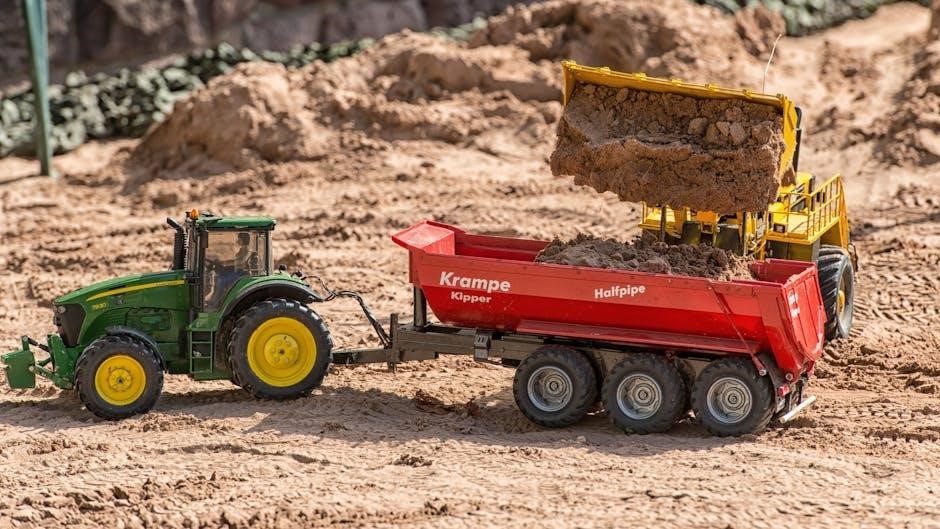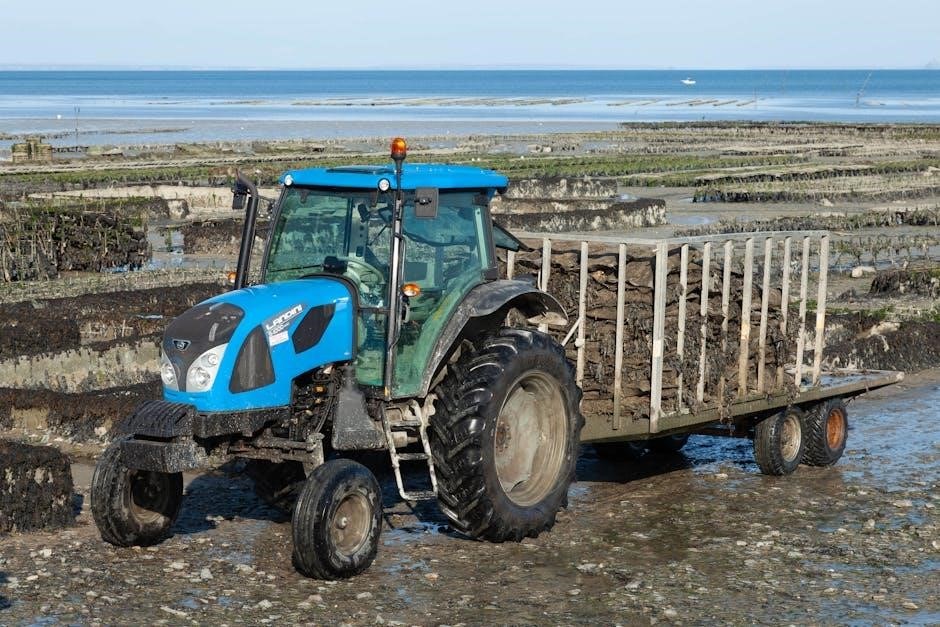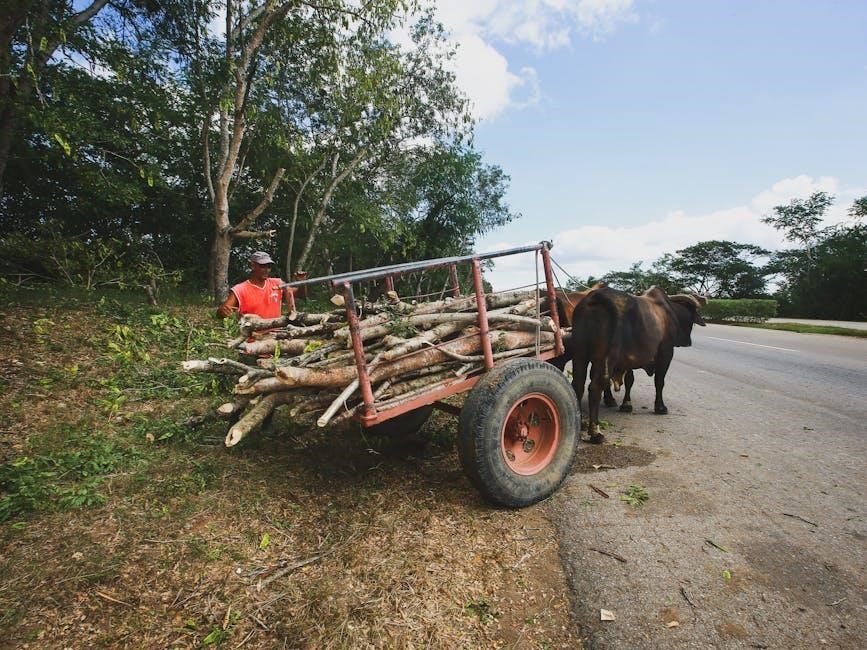
Safety Precautions Before Lowering a Dump Trailer
Always wear safety gear, ensure the trailer is on stable ground, and understand its components before lowering. Check hydraulic systems and test valves to maintain control during the process.
Ensure the area is clear of obstacles and personnel. Use safety cables if equipped, and follow the manufacturer’s guidelines to avoid accidents. Never proceed without proper preparation.

1.1 Essential Safety Gear
Before manually lowering a dump trailer, it is critical to wear and ensure the availability of essential safety gear. This includes a hard hat to protect against falling debris, safety glasses to prevent eye injuries, and sturdy gloves to maintain grip and protect hands from cuts or abrasions.
A high-visibility vest is also recommended to ensure visibility in low-light conditions or busy work environments. Steel-toe boots are mandatory to safeguard feet from heavy objects or tools. Additionally, consider wearing hearing protection if operating noisy equipment nearby.
Always inspect safety gear for damage before use and replace any compromised items. Properly secured gear ensures optimal protection. Remember, safety should never be compromised, as accidents can occur unexpectedly during the lowering process.
1.2 Ensuring a Stable Environment
Ensuring a stable environment is crucial before manually lowering a dump trailer; Begin by positioning the trailer on a flat, level surface to prevent uneven lowering or tipping. Engage the parking brake and chock the wheels to maintain stability and prevent unintended movement.
Clear the surrounding area of obstacles, bystanders, and loose debris to avoid accidents. Ensure the ground is firm and free from soft spots that could collapse under the trailer’s weight. If working on uneven terrain, use jack stands or stabilizing blocks for added support.
Check the trailer’s load distribution to ensure it is balanced, as an uneven load can destabilize the trailer during lowering. Use safety cables or chains if available to secure the trailer to a stationary object, providing an additional layer of safety.
1.3 Understanding Trailer Components
Understanding the components of your dump trailer is essential for safe and effective manual lowering. Familiarize yourself with the hydraulic system, which powers the lifting and lowering mechanisms. Locate the hydraulic release valve, responsible for controlling the trailer’s descent, and ensure it is functioning properly.
Inspect the safety cables or chains, which secure the trailer during operation. Know the location and operation of the hoist or lift mechanism, as well as the trailer jack, used for stabilizing the trailer when detached from the towing vehicle. Always consult the manufacturer’s manual to understand specific features of your trailer model.
Before lowering, visually inspect all components for wear or damage. Ensure all connections, such as the hitch and coupler, are secure. Understanding these components will help you operate the trailer safely and efficiently during the lowering process.

Tools and Equipment Needed

Essential tools include a wrench for releasing valves, a jack for stabilizing, and safety gear like gloves and glasses. Hydraulic systems may require specific handles or controls for manual operation.
Ensure you have a reliable means to control the trailer’s descent, such as a manual crank or lever. Additional equipment like blocks or stands can help secure the trailer once lowered.
2.1 Essential Tools for Manual Lowering
The process of manually lowering a dump trailer requires specific tools to ensure safety and efficiency. A heavy-duty wrench or socket wrench is necessary for releasing the hydraulic release valve, which initiates the lowering sequence.
A trailer jack or floor jack is essential for stabilizing the trailer during the process. Additionally, safety gear such as gloves, safety glasses, and steel-toe boots are crucial to protect against potential hazards.
It’s also advisable to have wooden blocks or jack stands on hand to secure the trailer once it’s lowered. A manual crank or lever may be required, depending on the trailer’s hydraulic system design.
Lastly, ensure all tools are in good condition and suitable for the weight and size of the trailer to avoid equipment failure during the operation.
2.2 Importance of Hydraulic Systems
Hydraulic systems play a critical role in the operation of dump trailers, enabling smooth and controlled lowering of heavy loads. These systems use pressurized fluid to power the lifting and lowering mechanisms, ensuring stability and safety during the process.
A well-maintained hydraulic system is essential for preventing sudden drops or malfunctions, which could lead to accidents or equipment damage. Regular checks of hydraulic fluid levels, hoses, and valves are vital to ensure optimal performance.
While manual lowering is possible, hydraulic systems streamline the process, reducing manual effort and the risk of human error. Properly functioning hydraulics are indispensable for safe and efficient trailer operation.

Step-by-Step Process to Manually Lower a Dump Trailer
- Disconnect the trailer and ensure the area is clear.
- Activate the hydraulic release valve slowly and carefully.
- Control the trailer’s descent using the manual override.
- Secure the trailer once fully lowered to prevent movement.
3;1 Disconnecting the Trailer Safely
Before manual lowering, ensure the dump trailer is disconnected from the towing vehicle securely. Engage the parking brake and use wheel chocks to prevent any unintended movement. Always wear safety gear, including gloves and safety glasses, to protect against potential hazards.
Verify that the trailer’s hydraulic system is in neutral and that all safety cables are properly attached. Ensure the area around the trailer is clear of personnel and obstacles. If equipped, engage the trailer’s master cylinder lock to maintain control during the disconnect process.
Double-check the hydraulic lines and connections for any leaks or damage before proceeding. Once disconnected, test the trailer’s brake system to ensure it is functioning correctly. This step is critical to maintain safety and control during the lowering process.
3.2 Activating the Hydraulic Release Valve
Activating the hydraulic release valve is a critical step in manually lowering a dump trailer. Begin by ensuring the trailer is stable and securely supported. Locate the hydraulic release valve, typically found near the trailer’s control panel or hydraulic system.
Before activating, check the hydraulic fluid level to ensure proper system operation. Slowly turn or pull the release valve to allow hydraulic pressure to be released gradually. Monitor the trailer’s movement closely, as sudden drops can occur if the valve is opened too quickly.
Use the control lever or button to regulate the hydraulic system’s pressure release. Ensure the trailer lowers evenly by checking the hydraulic lines for any blockages or leaks. Once the hydraulic system is fully depressurized, the trailer bed will begin its controlled descent.

Throughout this process, maintain a safe distance and be prepared to intervene if necessary. Always refer to the manufacturer’s instructions for specific guidance on activating the hydraulic release valve for your particular dump trailer model.

3.3 Controlling the Descent of the Trailer
Controlling the descent of the trailer requires precision and constant vigilance. Once the hydraulic release valve is activated, the trailer will begin to lower. Use the control mechanisms provided, such as levers or buttons, to regulate the speed of the descent.
Ensure the trailer lowers evenly by monitoring the hydraulic system’s performance; If the trailer starts to tilt or descend unevenly, stop the process immediately and check for any obstructions or malfunctions. Adjust the hydraulic valves as needed to maintain balance.
Keep a safe distance from the trailer during the lowering process. Use spotters if possible to provide additional oversight and ensure no one is in the trailer’s path. Avoid sudden movements or rapid descents, as they can lead to loss of control.
Continue to monitor the trailer’s descent until it reaches the ground. Once fully lowered, secure the trailer using the appropriate locking mechanisms to prevent any accidental movement. Always follow the manufacturer’s guidelines for controlling the descent to ensure safety and efficiency.

3.4 Securing the Trailer Once Lowered
Once the trailer is fully lowered, ensure it is properly secured to prevent any unintended movement. Engage the mechanical locks or latches on the hydraulic system to keep the trailer in place.
Use heavy-duty safety stands or jack stands to support the trailer’s frame, especially if it will remain lowered for an extended period. Check that the trailer is on level ground and stable before leaving it unattended.
Inspect the hydraulic lines and connections for any leaks or damage. If using safety cables, ensure they are securely attached to both the trailer and the towing vehicle.
Double-check all locking mechanisms and ensure the trailer’s brakes are engaged if equipped. Clear the area around the trailer to prevent accidents and ensure visibility for others.
Finally, confirm that all components are secure and the trailer is stable before considering the process complete. Always follow the manufacturer’s guidelines for securing the trailer post-lowering.

Common Issues and Solutions
Common issues include hydraulic leaks, stuck release valves, or uneven lowering. Solutions involve inspecting hydraulic systems, cleaning valves, and ensuring proper lubrication. Always use the correct tools and techniques to avoid malfunctions.
4.1 Identifying Common Problems
When manually lowering a dump trailer, common issues often arise from hydraulic system malfunctions or improper preparation. Hydraulic leaks, blocked valves, or insufficient fluid levels are frequent problems that can disrupt the process. Additionally, mechanical components such as the release valve or lift arms may become stuck due to lack of maintenance or debris buildup. Electrical issues, like faulty sensors or wiring problems, can also hinder the system’s performance. Another common problem is uneven lowering, which may result from improper load distribution or worn-out suspension parts. Operators should be vigilant in inspecting these components before and during the lowering process. Early detection of these issues is crucial to ensure safety and efficiency. Regular maintenance and proper usage of tools can significantly reduce the risk of encountering these problems. Always refer to the manufacturer’s guidelines for troubleshooting and repair.
4.2 Troubleshooting Hydraulic System Malfunctions
Hydraulic system malfunctions are common when manually lowering a dump trailer. Start by checking for hydraulic leaks, which can cause fluid loss and system failure. Inspect hoses and connections for damage or wear. Low hydraulic fluid levels or incorrect fluid types can also disrupt operation. Use a pressure gauge to test the system’s pressure, ensuring it matches the manufacturer’s specifications. Blocked valves or clogged filters may restrict fluid flow, requiring cleaning or replacement. If the hydraulic pump fails to engage, check the electrical connections and ensure the release valve is functioning properly; Always refer to the hydraulic system’s manual for specific troubleshooting steps. Regular maintenance, such as replacing worn seals and flushing old fluid, can prevent these issues. If problems persist, consult a professional mechanic or hydraulic specialist. Safety should always be the priority when diagnosing and repairing hydraulic systems.

Post-Lowering Procedures
Inspect the trailer for damage, ensure the dump bed is secure with locking mechanisms, and check the hydraulic system for leaks. Ensure all safety measures are in place.
5.1 Inspecting the Trailer After Lowering
After lowering the dump trailer, conduct a thorough inspection to ensure all components are in proper working condition. Start by visually examining the dump bed, ensuring it is fully lowered and secured with locking mechanisms. Check for any signs of damage or wear on the hydraulic cylinders, hoses, and connections, as leaks or damage can lead to malfunctions.
Inspect the trailer frame for any deformation or stress points, especially around the hinges and pivot points. Verify that the tires are secure, properly inflated, and show no signs of uneven wear. Ensure the coupler is tightly latched to the hitch and that all safety chains or cables are properly attached.
Test the brakes to confirm they are functioning correctly and ensure the trailer is stable on level ground. Finally, review the hydraulic system for any leaks or pressure issues. Address any issues immediately to prevent future problems during operation or transport.
5.2 Securing the Trailer for Safety
After lowering the dump trailer, it is crucial to secure it properly to prevent accidental movement. Start by engaging the trailer’s locking mechanisms, such as the dump bed locks or safety latches, to ensure the bed remains in place. Use wheel chocks to stabilize the tires and prevent rolling, especially on uneven surfaces.
Ensure the trailer is parked on level ground and apply the parking brake. If the trailer is equipped with safety chains or cables, attach them securely to the towing vehicle or a stationary object. This adds an extra layer of protection against unintended movement.
Finally, disconnect the trailer from the towing vehicle and store the coupling device safely. Regularly inspect the securing mechanisms to ensure they are in good condition. Properly securing the trailer is essential for safety and to comply with legal and regulatory requirements;